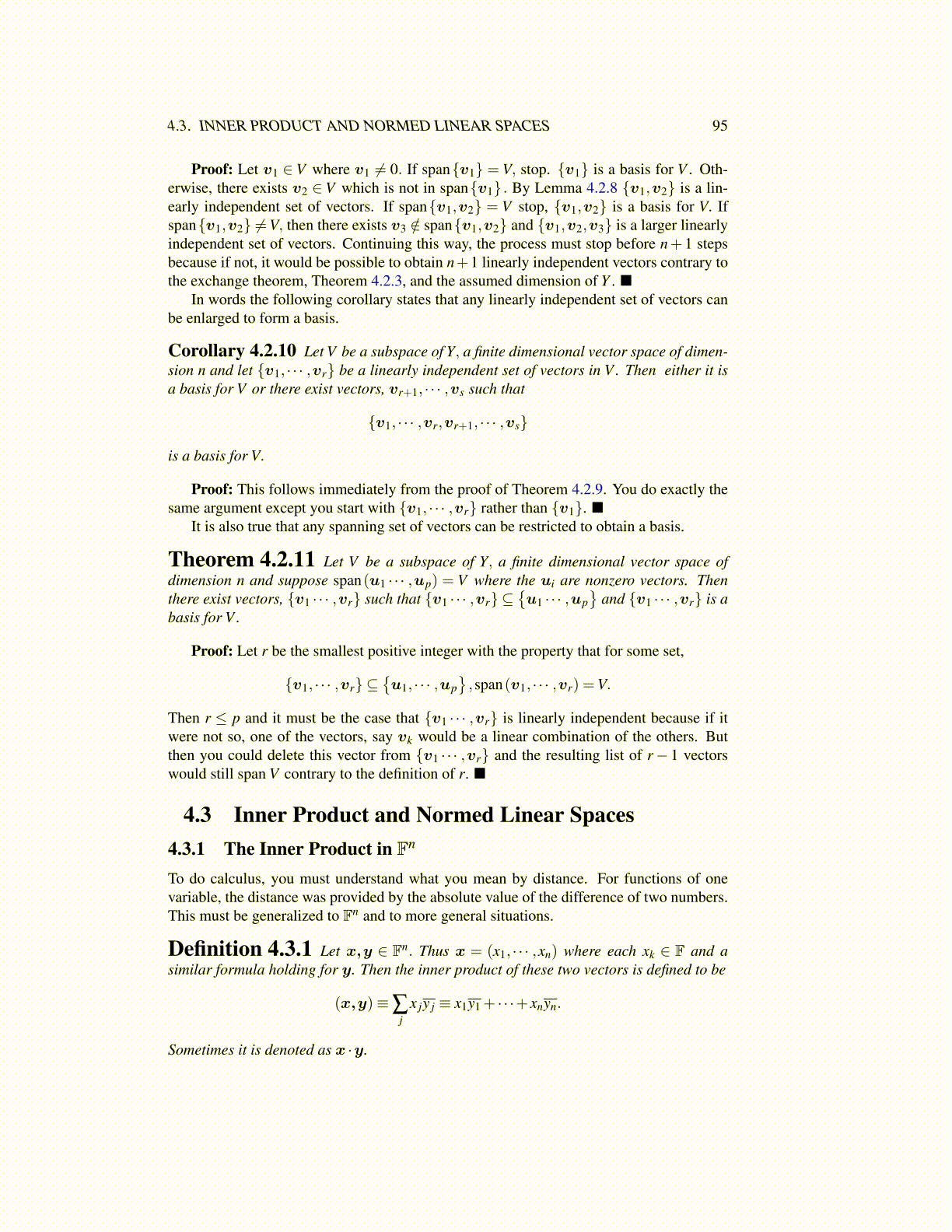
4.3. INNER PRODUCT AND NORMED LINEAR SPACES 95
Proof: Let v1 ∈ V where v1 ̸= 0. If span{v1} = V, stop. {v1} is a basis for V . Oth-erwise, there exists v2 ∈ V which is not in span{v1} . By Lemma 4.2.8 {v1,v2} is a lin-early independent set of vectors. If span{v1,v2} = V stop, {v1,v2} is a basis for V. Ifspan{v1,v2} ̸=V, then there exists v3 /∈ span{v1,v2} and {v1,v2,v3} is a larger linearlyindependent set of vectors. Continuing this way, the process must stop before n+ 1 stepsbecause if not, it would be possible to obtain n+1 linearly independent vectors contrary tothe exchange theorem, Theorem 4.2.3, and the assumed dimension of Y . ■
In words the following corollary states that any linearly independent set of vectors canbe enlarged to form a basis.
Corollary 4.2.10 Let V be a subspace of Y, a finite dimensional vector space of dimen-sion n and let {v1, · · · ,vr} be a linearly independent set of vectors in V . Then either it isa basis for V or there exist vectors, vr+1, · · · ,vs such that
{v1, · · · ,vr,vr+1, · · · ,vs}
is a basis for V.
Proof: This follows immediately from the proof of Theorem 4.2.9. You do exactly thesame argument except you start with {v1, · · · ,vr} rather than {v1}. ■
It is also true that any spanning set of vectors can be restricted to obtain a basis.
Theorem 4.2.11 Let V be a subspace of Y, a finite dimensional vector space ofdimension n and suppose span(u1 · · · ,up) = V where the ui are nonzero vectors. Thenthere exist vectors, {v1 · · · ,vr} such that {v1 · · · ,vr} ⊆
{u1 · · · ,up
}and {v1 · · · ,vr} is a
basis for V .
Proof: Let r be the smallest positive integer with the property that for some set,
{v1, · · · ,vr} ⊆{u1, · · · ,up
},span(v1, · · · ,vr) =V.
Then r ≤ p and it must be the case that {v1 · · · ,vr} is linearly independent because if itwere not so, one of the vectors, say vk would be a linear combination of the others. Butthen you could delete this vector from {v1 · · · ,vr} and the resulting list of r− 1 vectorswould still span V contrary to the definition of r. ■
4.3 Inner Product and Normed Linear Spaces4.3.1 The Inner Product in Fn
To do calculus, you must understand what you mean by distance. For functions of onevariable, the distance was provided by the absolute value of the difference of two numbers.This must be generalized to Fn and to more general situations.
Definition 4.3.1 Let x,y ∈ Fn. Thus x = (x1, · · · ,xn) where each xk ∈ F and asimilar formula holding for y. Then the inner product of these two vectors is defined to be
(x,y)≡∑j
x jy j ≡ x1y1 + · · ·+ xnyn.
Sometimes it is denoted as x ·y.